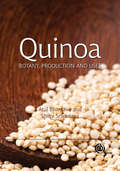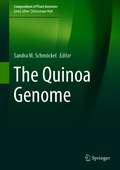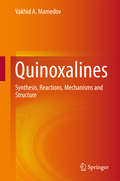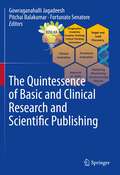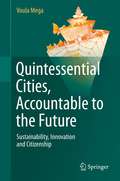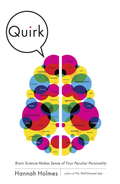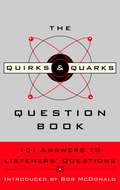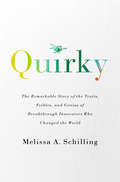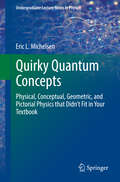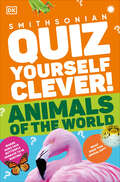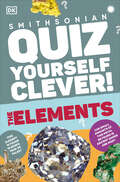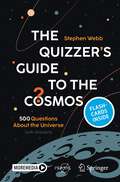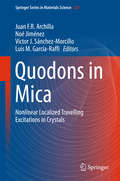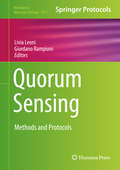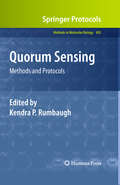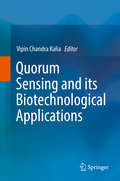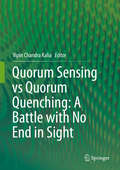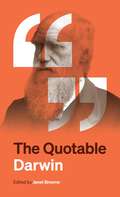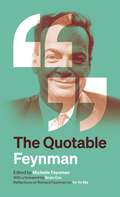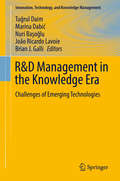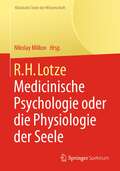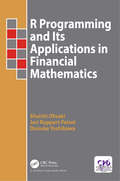- Table View
- List View
Quine and His Place in History (History of Analytic Philosophy)
by Frederique Janssen-Lauret Gary KempContaining three previously unpublished papers by W.V. Quine as well as historical, exegetical, and critical papers by several leading Quine scholars including Hylton, Ebbs, and Ben-Menahem, this volume aims to remedy the comparative lack of historical investigation of Quine and his philosophical context.
Quinoa: Botany, Production and Uses (Botany, Production and Uses)
by Atul Bhargava Shilpi Srivastava* Quinoa is an invaluable crop, highlighted by the FAO as one of the world’s main crops for future food security * Timely publication – The year 2013 has been declared "The International Year of the Quinoa" (IYQ), recognizing the Andean indigenous peoples, who have maintained, controlled, protected and preserved quinoa as food for present and future generations thanks to their traditional knowledge and practices of living well in harmony with mother earth and nature. * Covers the history, phylogeny and systematics, botany and agrotechnology
Quinoa
by Shilpi Srivastava Didier Bazile Enrique A Martínez Atul Bhargava Francisco Fuentes* Quinoa is an invaluable crop, highlighted by the FAO as one of the world's main crops for future food security * Timely publication - The year 2013 has been declared "The International Year of the Quinoa" (IYQ), recognizing the Andean indigenous peoples, who have maintained, controlled, protected and preserved quinoa as food for present and future generations thanks to their traditional knowledge and practices of living well in harmony with mother earth and nature. * Covers the history, phylogeny and systematics, botany and agrotechnology
The Quinoa Genome (Compendium of Plant Genomes)
by Sandra M. SchmöckelThis book focuses on quinoa, providing background information on its history, summarizing recent genetic and genomic advances, and offering directions for future research. Meeting the caloric and nutritional demands of our growing population will not only require increases in overall food production, but also the development of new crops that can be grown sustainably in agricultural environments that are increasingly susceptible to degradation. Quinoa is an ancient crop native to the Andean region of South America that has recently gained international attention because its seeds are high in protein, particularly in essential amino acids. Quinoa is also highly tolerant of abiotic stresses, including drought, frost and salinity. For these reasons, quinoa has the potential to help address issues of food security – a potential that was recognized when the United Nations declared 2013 the International Year of Quinoa. However, more effort is needed to improve quinoa agronomically and to understand the mechanisms of its abiotic stress tolerance; the recent development of genetic and genomic tools, including a reference genome sequence, will now help accelerate research in these areas.
Quinoxalines
by Vakhid A. MamedovThisbook reviews the fundamental aspects of quinoxaline chemistry: synthesis,reactions, mechanisms, structure, properties, and uses. The first four chapterspresent a survey of the developments in quinoxaline chemistry since thepublication of the monograph on "Condensed Pyrazines" by Cheeseman and Cooksonin 1979. These chapters give comprehensive coverage of all the methods of the synthesis of quinoxalinesand the important quinoxaline-containing ring systems suchas thiazolo[3,4-a]-, pyrrolo[1,2-a]-, and imidazo[1,5-a]quinoxalines. Chapter five describes many new methods for the construction of quinoxalinemacrocycles, which are important in applications such as optical devices andmaterials. The final chapter reviews all previously known rearrangements ofheterocyclic systems that lead to benzimidazole derivatives. Mamedov criticallyanalyses these transformations to reveal a novel acid-catalyzed rearrangementof quinoxalinones giving 2-heteroarylbenzimidazoles and1-heteroarylbenzimidazolones in the presence of nucleophilic reactants (MAMEDOVHeterocycle Rearrangement). This book is of interest to researchers in thefields of heterocyclic and synthetic organic chemistry.
The Quintessence of Basic and Clinical Research and Scientific Publishing
by Gowraganahalli Jagadeesh Pitchai Balakumar Fortunato SenatoreThe book, intended for biomedical researchers, attempts to foster a comprehensive understanding of the elements that impact scientific research, such as clinical trial design, communication, and publication methods. It introduces the process of idea generation and creative/critical thinking, leading to the development of key concepts that coalesce into theoretical constructs and working hypotheses. The book systematically delineates research phases associated with a bench-to-bedside translational approach, providing the full depth and breadth of drug discovery and development: design, synthesis, and optimization of drug candidates interacting with targets linked to diseases, as well as clinical trial design to acquire substantial evidence of efficacy and safety for candidate drugs in the target patient population. New and evolving topics such as artificial intelligence, machine and deep learning, drug repurposing approaches, and bioinformatics, are incorporated into the text as these features are becoming integrated into drug research and development. Additionally, it covers publication strategies, including literature search, manuscript preparation, data presentation, relevant discussion, editorial processes, elements of peer review, and bibliometrics. Finally, the book addresses grantsmanship, key strategies for building effective networks, mentorships, maintaining research integrity, and forging career advancement opportunities, including entrepreneurship.
Quintessential Cities, Accountable to the Future: Sustainability, Innovation and Citizenship
by Voula MegaThis book can be seen as the third part of an unofficial trilogy on Sustainable Cities of the Future with the author's previous books 'Sustainable Development, Energy and the City' and 'Sustainable Cities for the third millennium: The Odyssey of urban excellence', both prefaced by Prof. Sir Peter Hall. All three books follow the evolving forefront of innovations towards Sustainable Cities. They collectively try to respond to the questions: What future cities wish to build (with their scarcities and capacities) on a finite planet? What do-they do to achieve this? How do-they contribute to redesign the world? The third book adopts, first and foremost, a strategic foresight approach including a scan of the future trends, tensions and risks in a more uncertain world, the possible and preferable futures, emerging policy issues, such as intergenerational cities or cities welcoming the immigrants and their impact on sustainable development, the Rio+20 prospects and the effects of the protracted crisis, efforts by world interconnected cities, including a case-study on Bangkok, a laboratory of urban change, and examples of frugal and resilient urban policies.
Quirk: Brain Science Makes Sense of Your Peculiar Personality
by Hannah HolmesWho are you? It's the most fundamental of human questions. Are you the type of person who tilts at windmills, or the one who prefers to view them from the comfort of an air-conditioned motorcoach? Our personalities are endlessly fascinating--not just to ourselves but also to our spouses, our parents, our children, our co-workers, our neighbors. As a highly social species, humans have to navigate among an astonishing variety of personalities. But how did all these different permutations come about? And what purpose do they serve? With her trademark wit and sly humor, Hannah Holmes takes readers into the amazing world of personality and modern brain science. Using the Five Factor Model, which slices temperaments into the major factors (Extraversion, Neuroticism, Agreeableness, Conscientiousness, and Openness) and minor facets (such as impulsive, artistic, or cautious), Holmes demonstrates how our genes and brains dictate which factors and facets each of us displays. Are you a Nervous Nelly? Your amygdala is probably calling the shots. Hyperactive Hal? It's all about the dopamine. Each facet took root deep in the evolution of life on Earth, with Nature allowing enough personal variation to see a species through good times and bad. Just as there are introverted and extroverted people, there are introverted and extroverted mice, and even starfish. In fact, the personality genes we share with mice make them invaluable models for the study of disorders like depression, schizophrenia, and anxiety. Thus it is deep and ancient biases that guide your dealings with a very modern world. Your personality helps to determine the political party you support, the car you drive, the way you eat M&Ms, and the likelihood that you'll cheat on your spouse. Drawing on data from top research laboratories, the lives of her eccentric friends, the conflicts that plague her own household, and even the habits of her two pet mice, Hannah Holmes summarizes the factors that shape you. And what she proves is that it does take all kinds. Even the most irksome and trying personality you've ever encountered contributes to the diversity of our species. And diversity is the key to our survival.
Quirks of Human Anatomy: An Evo-devo Look at the Human Body
by Lewis I. Held Jr.With the emergence of the new field of evolutionary developmental biology we are witnessing a renaissance of Darwin's insights 150 years after his Origin of Species. Thus far, the exciting findings from "evo-devo" have only been trickling into college courses and into the domain of non-specialists. With its focus on the human organism, Quirks of Human Anatomy opens the floodgates by stating the arguments of evo-devo in plain English, and by offering a cornucopia of interesting case studies and examples. Its didactic value is enhanced by 24 schematic diagrams that integrate a host of disparate observations, by its Socratic question-and-answer format, and by its unprecedented compilation of the literature. By framing the "hows" of development in terms of the "whys" of evolution, it lets readers probe the deepest questions of biology. Readers will find the book not only educational but also enjoyable, as it revels in the fun of scientific exploration.
The Quirks & Quarks Question Book: 101 Answers to Listeners' Questions
by Bob Mcdonald* Is there really such a thing as a blue moon?* What time is it at the North Pole?* Why don't woodpeckers get concussed?* Why don't snorers wake themselves with the racket they make?* Do insects sleep?These are just a few of the intriguing questions asked and answered in The Quirks & Quarks Question Book, the first question and answer book to come out of CBC Radio's enormously popular weekly science program. Quirks & Quarks producers have combed through ten years' worth of archives to find the most puzzling questions - or the most fascinating answers to apparently simple questions - from the program's Question of the Week segment or its once-a-season all-question show. The scientists and researchers with the answers (many of whom updated their answers for the book in light of new research findings) come from all scientific disciplines and all parts of the country. What they have in common is their ability to explain serious, complicated science in layman's terms. This isn't science made simple, but science made understandable.Introduced by the program's host for the past ten years, the genial and ever-curious Bob McDonald, The Quirks & Quarks Question Book has the answers to questions you may never have thought to ask (why does Uranus spin on a different axis from all the other planets in our solar system?) or have spent idle time wondering about (why is there a calm before a storm?). Whether you want to know if you can sweat while you swim or what the view would be like if you could travel at the speed of light, or perhaps you just want to peruse the latest scientific thinking on a wide range of topics, The Quirks & Quarks Question Book has the answer.Quirks & Quarks has been keeping Canadians up to date on the world of science for more than 25 years. Every week, the program presents the people behind the latest discoveries in the physical and natural sciences. The program also examines the political, social, environmental, and ethical implications of new developments in science and technology. Over its lifetime, Quirks & Quarks has won more than 40 national and international awards for science journalism.From the Trade Paperback edition.
Quirky: The Remarkable Story of the Traits, Foibles, and Genius of Breakthrough Innovators Who Changed the World
by Melissa A SchillingThe science behind the traits and quirks that drive creative geniuses to make spectacular breakthroughsWhat really distinguishes the people who literally change the world--those creative geniuses who give us one breakthrough after another? What differentiates Marie Curie or Elon Musk from the merely creative, the many one-hit wonders among us?Melissa Schilling, one of the world's leading experts on innovation, invites us into the lives of eight people--Albert Einstein, Benjamin Franklin, Elon Musk, Dean Kamen, Nikola Tesla, Marie Curie, Thomas Edison, and Steve Jobs--to identify the traits and experiences that drove them to make spectacular breakthroughs, over and over again. While all innovators possess incredible intellect, intellect alone, she shows, does not create a breakthrough innovator. It was their personal, social, and emotional quirkiness that enabled true genius to break through--not just once but again and again.Nearly all of the innovators, for example, exhibited high levels of social detachment that enabled them to break with norms, an almost maniacal faith in their ability to overcome obstacles, and a passionate idealism that pushed them to work with intensity even in the face of criticism or failure. While these individual traits would be unlikely to work in isolation--being unconventional without having high levels of confidence, effort, and goal directedness might, for example, result in rebellious behavior that does not lead to meaningful outcomes--together they can fuel both the ability and drive to pursue what others deem impossible. Schilling shares the science behind the convergence of traits that increases the likelihood of success. And, as Schilling also reveals, there is much to learn about nurturing breakthrough innovation in our own lives--in, for example, the way we run organizations, manage people, and even how we raise our children.
Quirky Quantum Concepts
by Eric L. MichelsenQuirky Quantum Concepts explains the more important and more difficult concepts in theoretical quantum mechanics, especially those which are consistently neglected or confusing in many common expositions. The emphasis is on physical understanding, which is necessary for the development of new, cutting edge science. In particular, this book explains the basis for many standard quantum methods, which are too often presented without sufficient motivation or interpretation. The book is not a simplification or popularization: it is real science for real scientists. Physics includes math, and this book does not shy away from it, but neither does it hide behind it. Without conceptual understanding, math is gibberish. The discussions here provide the experimental and theoretical reasoning behind some of the great discoveries, so the reader may see how discoveries arise from a rational process of thinking, a process which Quirky Quantum Concepts makes accessible to its readers. Quirky Quantum Concepts is therefore a supplement to almost any existing quantum mechanics text. Students and scientists will appreciate the combination of conversational style, which promotes understanding, with thorough scientific accuracy.
Quiz Yourself Clever! Animals of the World (DK Quiz Yourself Clever )
by DKDiscover your own inner Attenborough with this fact-packed, quick-quiztastic book, which covers more than 120 animals, from terrifying tigers to adorable apes!This amazing book welcomes you to the animal kingdom where you can meet more than 100 species, ranging from lions to butterflies and everything in between. Stunning pictures and fast facts will allow you to amass a wealth of knowledge in a fun way. Meet familiar creatures, including polar bears and tigers, and unbelievable ones, such as a vampire bat and a trumpetfish, with each animal having its own quiz questions to test your knowledge on what you've learned. For even more fun, get friends involved and quiz each other!Every creature is shown in beautiful detail, with quiz questions surrounding its portrait. Turn the page to find the answers to the questions—delivered in fast-fact style, including what they eat, where they live, how big they are compared to humans, and more images and facts. A jaw-dropping spectrum of animal types—from fish and birds to reptiles and mammals—provides a learning experience like no other!
Quiz Yourself Clever! Elements (DK Quiz Yourself Clever )
by DKGet to grips with the elements through fun quizzes.The periodic table sets out the humble ingredients of everything in the universe, but with 118 elements, that's a lot of ingredients to remember! This is where Quiz Yourself Clever! Elements comes in.The pure form of every element on the periodic table is shown via an eye-catching image, surrounded by quiz-style questions. Turn the page to find the answers, contained in a handy dataset, from its atomic number and mass to its melting point, and even when it was discovered. Images of how it appears in nature and its uses give a fuller understanding of each element.You can use the book to test your own knowledge, or how about using it to quiz a friend? So, whether you're studying for exams, want to play fun games with friends, or you're just curious about the building blocks of everything around you, you'll be in your element with this book before you know it!
The Quizzer’s Guide to the Cosmos: 500 Questions About the Universe (with Answers) (Springer Praxis Books)
by Stephen WebbHave you ever gazed up at the night sky and wondered how many stars you can see? Whether the universe is infinite? Or, more prosaically, what the chances are of you being hit by a rock from space? The Quizzer’s Guide to the Cosmos is here to satisfy your curiosity by offering an overview of the history of astronomy, from the earliest beginnings through to the most recent discoveries. This isn’t a typical astronomy book, however — it’s packed with a 500-question multiple-choice quiz that not only makes the book more interactive but also helps you retain information and lets you test your knowledge of some of the most captivating concepts in science. The book will appeal to astronomy buffs and to general quiz afficianados alike. Digital questions and answers also via app: Download the Springer Nature Flashcards app free of charge and test your knowledge.
Quodons in Mica
by Juan F. R. Archilla Noé Jiménez Victor J. Sánchez-Morcillo Luis M. García-RaffiThis book presents the current knowledge about nonlinear localized travelling excitations in crystals. Excitations can be vibrational, electronic, magnetic or of many other types, in many different types of crystals, as silicates, semiconductors and metals. The book is dedicated to the British scientist FM Russell, recently turned 80. He found 50 years ago that a mineral mica muscovite was able to record elementary charged particles and much later that also some kind of localized excitations, he called them quodons, was also recorded. The tracks, therefore, provide a striking experimental evidence of quodons existence. The first chapter by him presents the state of knowledge in this topic. It is followed by about 18 chapters from world leaders in the field, reviewing different aspects, materials and methods including experiments, molecular dynamics and theory and also presenting the latest results. The last part includes a personal narration of FM Russell of the deciphering of the marks in mica. It provides a unique way to present the science in an accessible way and also illustrates the process of discovery in a scientist's mind.
Quorum Sensing
by Livia Leoni Giordano RampioniThis detailed volume provides scientists interested in quorum sensing with a broad spectrum of methods and protocols useful for studying bacterial communication processes at the chemico-physical, molecular, and physiological level. Divided into three sections, the content covers detection and quantification of quorum sensing signal molecules, methods for the studying of quorum sensing at the molecular, physiological, and population level, as well as identification and characterization of anti-quorum sensing agents. Written for the highly successful Methods in Molecular Biology series, chapters include introductions to their respective topics, lists of the necessary materials and reagents, step-by-step, readily reproducible laboratory protocols, and tips on troubleshooting and avoiding known pitfalls. Authoritative and cutting-edge, Quorum Sensing: Methods and Protocols serves as a comprehensive guide to the most important methodology currently available in the field.
Quorum Sensing
by Kendra P. RumbaughSince its early days in the 1990s, the Quorum Sensing (QS) field has grown from a few dozen laboratories, investigating the pathways, proteins, and chemicals that facilitate signaling in bacteria, to hundreds of groups that have integrated evolutionary biology, computer science, mathematics, engineering, and metagenomics to create an ever-expanding and dynamic field. In Quorum Sensing: Methods and Protocols, expert researchers provide an in-depth set of diverse protocols that span this broad area of study. Broken into three detailed sections, the volume covers the detection, isolation, and characterization of the QS signals made by both Gram- and Gram+ bacteria, determination of the function of QS signals in vivo, and the development of QS disruption strategies. Written in the highly successful Methods in Molecular BiologyTM series format, chapters include brief introductions to their respective topics, lists of the necessary materials and reagents, step-by-step, readily reproducible laboratory protocols, and expert tips on troubleshooting and avoiding known experimental pitfalls. Comprehensive and cutting-edge, Quorum Sensing: Methods and Protocols serves as an invaluable collection of easily accessible techniques for scientists seeking to further our knowledge about bacterial communication and its relation to humanity.
Quorum Sensing and its Biotechnological Applications
by Vipin Chandra KaliaThis book delves into the biotechnological applications of Quorum sensing (QS)- a peculiar gene-regulatory process of some microorganisms. Quorum Sensing allows a large bacterial population to work together in a coordinated manner to carry out metabolic activities, which individual bacterium cannot. The different chapters describe how, associating bioremediation process with energy generation is an economical proposal, for reducing pollution and managing biowastes. The book discusses how QS can be exploited for biotechnological applications in generating bioproducts, bioenergy, bioremediation, biosensors, health and agricultural activities. It further highlights how QS is becoming an integral part of synthetic biology for genetic circuits for producing: (i) novel products, (ii) biosensors, (iii) bioactive molecules, etc. The book is divided into different sections for a clear understanding of the applicability of QS in, the Environment, Energy, Agriculture and Health sectors.
Quorum Sensing vs Quorum Quenching: A Battle with No End in Sight
by Vipin Chandra KaliaMicrobial relationships with all life forms can be as free living, symbiotic or pathogenic. Human beings harbor 10 times more microbial cells than their own. Bacteria are found on the skin surface, in the gut and other body parts. Bacteria causing diseases are the most worrisome. Most of the infectious diseases are caused by bacterial pathogens with an ability to form biofilm. Bacteria within the biofilm are up to 1000 times more resistant to antibiotics. This has taken a more serious turn with the evolution of multiple drug resistant bacteria. Health Departments are making efforts to reduce high mortality and morbidity in man caused by them. Bacterial Quorum sensing (QS), a cell density dependent phenomenon is responsible for a wide range of expressions such as pathogenesis, biofilm formation, competence, sporulation, nitrogen fixation, etc. Majority of these organisms that are important for medical, agriculture, aquaculture, water treatment and remediation, archaeological departments are: Aeromonas, Acinetobacter, Bacillus, Clostridia, Enterococcus, Pseudomonas, Vibrio and Yersinia spp. Biosensors and models have been developed to detect QS systems. Strategies for inhibiting QS system through natural and synthetic compounds have been presented here. The biotechnological applications of QS inhibitors (QSIs) in diverse areas have also been dealt with. Although QSIs do not affect growth and are less likely to impose selective pressure on bacteria, however, a few reports have raised doubts on the fate of QSIs. This book addresses a few questions. Will bacteria develop mechanisms to evade QSIs? Are we watching yet another defeat at the hands of bacteria? Or will we be acting intelligently and survive the onslaughts of this Never Ending battle?
The Quotable Darwin
by Janet BrowneA treasure trove of illuminating and entertaining quotations from the legendary naturalistHere is Charles Darwin in his own words—the naturalist, traveler, scientific thinker, and controversial author of On the Origin of Species, the book that shook the Victorian world. Featuring hundreds of quotations carefully selected by world-renowned Darwin biographer Janet Browne, The Quotable Darwin draws from Darwin’s writings, letters to friends and family, autobiographical reminiscences, and private scientific notebooks. It offers a multifaceted portrait that takes readers through his youth, the famous voyage of the Beagle, the development of his thoughts about evolution, his gradual loss of religious faith, and the time spent turning his ideas into a well-articulated theory about the natural origin of all living beings—a theory that dangerously included the origin of humans.The Quotable Darwin also includes many of the key responses to Darwin’s ideas from figures across the social spectrum, scientists and nonscientists alike—and criticism too. We see Darwin as an innovative botanist and geologist, an affectionate husband and father, and a lively correspondent who once told his cousin that he liked to play billiards because “it drives the horrid species out of my head.” This book gives us an intimate look at Darwin at work, at home, as a public figure, and on his travels.Complete with a chronology of Darwin’s life by Browne, The Quotable Darwin provides an engagingly fresh perspective on a remarkable man who was always thinking deeply about the natural world.
The Quotable Feynman
by Richard P. FeynmanA treasure-trove of illuminating and entertaining quotations from beloved physicist Richard P. Feynman"Some people say, ‘How can you live without knowing?' I do not know what they mean. I always live without knowing. That is easy. How you get to know is what I want to know."—Richard P. FeynmanNobel Prize–winning physicist Richard P. Feynman (1918–88) was that rarest of creatures—a towering scientific genius who could make himself understood by anyone and who became as famous for the wit and wisdom of his popular lectures and writings as for his fundamental contributions to science. The Quotable Feynman is a treasure-trove of this revered and beloved scientist's most profound, provocative, humorous, and memorable quotations on a wide range of subjects.Carefully selected by Richard Feynman's daughter, Michelle Feynman, from his spoken and written legacy, including interviews, lectures, letters, articles, and books, the quotations are arranged under two dozen topics—from art, childhood, discovery, family, imagination, and humor to mathematics, politics, science, religion, and uncertainty. These brief passages—about 500 in all—vividly demonstrate Feynman's astonishing yet playful intelligence, and his almost constitutional inability to be anything other than unconventional, engaging, and inspiring. The result is a unique, illuminating, and enjoyable portrait of Feynman's life and thought that will be cherished by his fans at the same time that it provides an ideal introduction to Feynman for readers new to this intriguing and important thinker.The book features a foreword in which physicist Brian Cox pays tribute to Feynman and describes how his words reveal his particular genius, a piece in which cellist Yo-Yo Ma shares his memories of Feynman and reflects on his enduring appeal, and a personal preface by Michelle Feynman. It also includes some previously unpublished quotations, a chronology of Richard Feynman's life, some twenty photos of Feynman, and a section of memorable quotations about Feynman from other notable figures.Features:Approximately 500 quotations, some of them previously unpublished, arranged by topicA foreword by Brian Cox, reflections by Yo-Yo Ma, and a preface by Michelle FeynmanA chronology of Feynman's lifeSome twenty photos of FeynmanA section of quotations about Feynman from other notable figuresSome notable quotations of Richard P. Feynman:"The thing that doesn't fit is the most interesting.""Thinking is nothing but talking to yourself inside.""It is wonderful if you can find something you love to do in your youth which is big enough to sustain your interest through all your adult life. Because, whatever it is, if you do it well enough (and you will, if you truly love it), people will pay you to do what you want to do anyway.""I'd hate to die twice. It's so boring."
R&D Management in the Knowledge Era: Challenges of Emerging Technologies (Innovation, Technology, and Knowledge Management)
by Tuğrul Daim Marina Dabić Nuri Başoğlu João Ricardo Lavoie Brian J. GalliThis volume explores emerging models, methods and tools in the management of research and development (R&D) in the knowledge era, with a particular focus on the challenges of the emerging technologies. The contributions are organized in five parts. Part I, Managing Emerging Technologies, provides methods and tools to understand the challenges created by the emergence of new technologies. Part II, Technology and Engineering Management Tools and Policies, explores different technology and engineering tools, including topics such as product concept development, design, selection and adoption, using technology roadmaps and bibliometrics. Part III, Technological Innovation and Entrepreneurship, explores R&D, knowledge transfer and entrepreneurial education. Part IV, Commercialization of Technological Innovations, explores the development and application of the technology transfer process which allows managers to succeed in commercializing the outcomes of R&D projects. Part V, Managing the Engineering Enterprise, explores the effect economic decision-making, leadership styles, change management and quality management have on an organization’s ability to plan and execute initiatives and projects. Research and Development has always played a critical role in the engineering and technology focused industries. In an era of big data and smart applications, knowledge has become a key enabler for R&D. Managing R&D in the knowledge era requires use of key tools and methods. However, emerging technologies pose many challenges and cause uncertainties or discontinuities, which make the task of managing R&D even more difficult. This book will examine these challenges and provide tools and methods to overcome them. Exploring such industries as automotive, healthcare, business intelligence, energy and home appliances, this book is a valuable resource for academics, scholars, professionals and leaders in innovation, R&D, technology, and engineering management.
R.H. Lotze: Medicinische Psychologie oder die Physiologie der Seele (Klassische Texte der Wissenschaft)
by Nikolay MilkovOriginaltext mit philosophischen sowie historischen Kommentaren von Nikolay Milkov Als habilitierter Mediziner und Philosoph hat Rudolph Hermann Lotze durch seinen interdisziplinären Ansatz die Entwicklung der Psychologie im 19. Jahrhundert wie kein anderer geprägt. Im Unterschied zu anderen Wissenschaftlern der Zeit hat Lotze die neue Disziplin konsequent in enger Verbindung mit der Philosophie betrachtet, wie besonders in Medicinische Psychologie oder Physiologie der Seele (1852) deutlich wird. Dies bedeutete seine bewusste Abkehr von der Herangehensweise, die Psychologie ganz über experimentelle Untersuchungen und damit die Empirie zu definieren. Lotze scheute sich jedoch, diese entstehende Disziplin „philosophische Psychologie“ zu nennen, für ihn war sie nur physiologische Psychologie, herausgearbeitet mit Hilfe der Philosophie: Sie stellt Tatsachen fest und untersucht, wie Körper und Seele sich zueinander verhalten, tut dies jedoch nicht nur empirisch, sondern auch „metaphysisch“. In diesem Band wird Lotzes Originaltext untersucht, kommentiert und eingebettet in den soziokulturellen Hintergrund der Entstehungszeit, um einen tiefen, aber verständlichen Einblick in diesen Bereich der Psychologie zu geben.
R Programming and Its Applications in Financial Mathematics
by Shuichi Ohsaki Jori Ruppert-Felsot Daisuke YoshikawaThis book provides an introduction to R programming and a summary of financial mathematics. <P><P>It is not always easy for graduate students to grasp an overview of the theory of finance in an abstract form. For newcomers to the finance industry, it is not always obvious how to apply the abstract theory to the real financial data they encounter. Introducing finance theory alongside numerical applications makes it easier to grasp the subject. <P><P>Popular programming languages like C++, which are used in many financial applications are meant for general-purpose requirements. They are good for implementing large-scale distributed systems for simultaneously valuing many financial contracts, but they are not as suitable for small-scale ad-hoc analysis or exploration of financial data. The R programming language overcomes this problem. R can be used for numerical applications including statistical analysis, time series analysis, numerical methods for pricing financial contracts, etc. <P><P>This book provides an overview of financial mathematics with numerous examples numerically illustrated using the R programming language.

